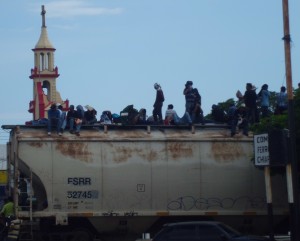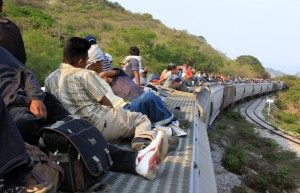
On Friday, June 23 a group of Central American migrants crossing Mexico by freight train en route to the United States were kidnapped at gunpoint in Medias Aguas, Veracruz. The kidnapping took place the day after the dialogue between members of the Caravan for Peace with Justice and Dignity and President Felipe Calderón about security and spiraling violence under the president’s war on drug trafficking. In Mexico City, delegates of the Caravan demanded an end to the drug war while Calderón defended his strategy against organized crime and narcotrafficking, asserting that, if anything, the militarized strategy should have begun sooner.
The Insecurity of Security Policies
Migrant kidnappings reflect the inability and unwillingness of the Mexican government to protect vulnerable groups such as these Central American transmigrants in the context of the violence unleashed under the drug war. They also reveal the costs of a broader “security” policy in both Mexico and the United States that criminalizes migrants rather than defending their lives, security, and rights.
Catholic priest Alejandro Solalinde denounced the kidnappings based on reports from migrants who managed to flee the captors. Solalinde is director of the shelter Casa del Migrante “Hermanos en el Camino” (Migrant House “Brothers and Sisters on the Road”) in Ixtepec, Oaxaca and Coordinator of the Pastoral of Human Mobility for Mexico’s Southern Pacific Region. A bulletin released from the shelter on June 24 reported that a freight train carrying about 250 migrants atop was stopped near the Medias Aguas station and met by a group of at least ten men armed with high power weapons.
“Some [migrants] ran into the bushes to save their lives and those that could not escape were captured by these people and taken in SUVs to unknown destinations.” Based on how many migrants were on the train when it was stopped, migrants and shelter workers estimated that 60 to 100 migrants were kidnapped, including women, men, and children.
Following the report of the kidnapping, the immediate response of Mexican government officials and institutions was denied. Officials from the state government of Veracruz, the Attorney General’s Office and the National Migration Institute (INM) stated that the kidnappings could not be confirmed and were nothing more than rumors. Several officials insisted that Father Solalinde himself present evidence of the crime.
When questioned by legislators of Mexico’s three main political parties, immigration commissioner Salvador Beltrán del Río admitted that there were pockets of corruption within the INM, but continued to deny any mass disappearance in Medias Aguas. Father Solalinde has proposed eliminating the INM altogether given the corruption within the institution and the involvement of its officials in abusing migrants.
At present the migrants remain unaccounted for while government officials continue to deny that the kidnapping took place and fail to carry out a serious investigation.
Subject to Abuse

What officials cannot deny is the extreme suffering and vulnerability of Central American migrants crossing Mexico. Without money to pay polleros (human smugglers) and to avoid checkpoints, thousands of migrants ride on the tops and sides of railcars where they are exposed to rain, extreme temperatures, dehydration, and electrocution. Many have lost limbs or their lives as a result of falling from the trains.
Traveling underground, migrants are vulnerable to assault, robbery, extortion, rape, and death. The recent kidnappings of migrants in Veracruz–whatever the number–are a small part of the thousands of kidnappings that take place each year, likely at the hands of narcotraffickers. In February of this year, Mexico’s National Commission of Human Rights reported that over 11,000 kidnappings of migrants had taken place in the six month period from April to September of 2010, the largest number occurring in the state of Veracruz.
Of those presenting testimony to the Commission, 8.9% pointed to the involvement of government authorities including police and immigration officials. The kidnappings bear an eerie resemblance to the disappearances of the 1970s and 1980s in Argentina, Guatemala, and other Latin American countries. The migrants are rarely found, cases remain unresolved, and fear is planted widely. The brutal massacre of 72 Central American migrants in Mexico’s northern state of Tamaulipas in August of 2010 confirmed death as a possible, if not likely, outcome of the kidnappings and also made it more difficult for authorities to deny the crisis.
I was at the shelter Hogar de la Misericordia (Home of Mercy) in Arriaga, Chiapas when the migrants heard the news of the kidnapping. The train begins its journey north in Arriaga, a small city near the border of Oaxaca. Migrants gather there as they wait to jump the next train.
Although concerned about the kidnappings and other violence they might face, the migrants were not deterred. Many told me that they had no choice but to continue their journey. They noted the vast disparity between wages in Central America and the United States, and the difficulty of finding work in their home countries. Some had family, including spouses and children, living in the United States. One migrant I spoke with said he was determined to reach the U.S., despite his poor health and the risks involved. Another man affirmed that if he could find work in his home country he wouldn’t migrate. Other migrants agreed.
U.S. Policy Places Migrants in Danger
The risks migrants face come not only from negligence and abuse from Mexican government agencies, but also from U.S. policy related to immigration, border control, and security. Rather than being protected by national and international security policies, migrants in Mexico and the U.S. are the direct targets of security policies. Increased immigration enforcement at Mexico’s northern and southern borders coincided with the North American Free Trade Agreement, which exacerbated the conditions for peasants to leave their lands due to the impossibility of competing with subsidized corn and other products from the U.S.
At the U.S.–Mexico border, policies such as Operation Blockade (launched in El Paso, Texas in 1993) and Operation Gatekeeper (San Diego, California) pushed migrants away from crossing at settled, urban areas toward dangerous regions including the Arizona desert. As a result, some 3,000 -5,000 migrants have died in the past 15 years in what immigrant rights activist Maria Jimenez labels “death by policy.”
In a 2010 report published by Mexico’s National Commission of Human Rights and the American Civil Liberties Union, “Humanitarian Crisis: Migrant Deaths at the U.S.-Mexico Border”, Jimenez documents that U.S. authorities are aware of this outcome. As Timothy Dunn notes in Blockading the Border and Human Rights, these enforcement operations became the basis of the Border Patrol’s “prevention through deterrence” policy with the goal of stopping undocumented migrants from entering the U.S.
Deterrence policies have reached southern Mexico where migration officials have increased enforcement strategies, especially along the Isthmus de Tehuantepec, Mexico’s narrowest point. This is a security strategy encouraged by the United States to limit Central American migration. Most recently, the U.S.-backed Plan Mexico, also known as the Mérida Initiative, provided significant funding to Mexico with the stated intention of “security aid to design and carry out counter-narcotics, counter-terrorism, and border security measures.” As former assistant Secretary of State Thomas Shannon observed in April of 2008, “To a certain extent, we’re armoring NAFTA.” What he does not say is that in doing so, poor and working class migrants, among other groups, are left unprotected by the “armor” and even become targets of security measures.
In early June of this year Mexico’s Attorney General Marisela Morales declared that protecting Mexico’s southern border was an issue of national security. She stated that the “illegal flow of people and merchandise that exists and the delinquency it generates demand a strengthened institutional coordination to improve vigilance, security, and respect for human rights.”
If undocumented migrants passing through the region are part of the “illegal flow of people,” then rather than being the subjects of respect of human rights, they are viewed as generating delinquency. This framework partly explains the actions and inactions of the Mexican, U.S., and Central American governments that lead to the human rights abuses of migrants. These governments, along with transnational corporations, create the economic conditions that cause migration. Enforcement policies, including checkpoints on highways and along the U.S.-Mexico border, push people to travel in extremely dangerous conditions and create a market for human smuggling. Finally, impunity perpetuates abuses as those responsible are not prosecuted.
In the U.S. migrants are increasingly criminalized. A new wave of anti-immigrant laws are being pushed at the state and local levels, including a law recently signed by the governor of South Carolina to create an Illegal Immigration Enforcement Unit as part of the state’s public safety department.
U.S. national security is increasingly linked to immigration control. A report published by the National Network for Immigrant and Refugee Rights in December 2010 titled “Injustice for All: The Rise of the U.S. Immigration Policing Regime” details the ways immigration control and policing in the U.S. have led to “racial discrimination and hate violence against immigrants and those perceived to be foreign born or ‘illegal.’” It also documents increased detentions and deportations, collaboration between police and immigration agents, workplace policing strategies leading to worker rights violations, militarization of border communities, and anti-immigration legislative proposals at all levels.
The Mexican and US government can deny human rights abuses of migrants, renounce responsibility, or blame non-state criminal elements and the harsh desert climate. But that doesn’t change the fact that the policies of these governments are directly linked to migrant death. From Hogar de la Misericordia in southern Mexico, the migrants insisted that looking for work should not be a crime.
The governments of North and Central America have a shared responsibility to stop the current human rights crisis faced by Central American migrants crossing Mexico and that of Mexicans crossing the U.S.-Mexico border. Fundamental political and economic policy changes are required so that Central American and Mexicans will not have to leave their countries in search of work.
Several questions remain unaddressed. What would be necessary so that no migrant would have to ride the freight train or cross the Arizona desert? What would be needed so that no migrant would have to risk his or her life to search for work? Without safe ways for workers to move across borders, enforcement and militarization will continue to cause deaths. Economic policies that allow people to provide for their families without having to leave their countries would be not only more cost effective but much more humane than enforcement-only policies, negligence, and denial that end in death.
Christine Kovic is Associate Professor of Anthropology at the University of Houston-Clake. She has conducted research on human rights in Chiapas, Mexico for nearly two decades. Her current research addresses immigrant rights in Mexico and the United States. She writes on immigration and human rights for the Americas Program www.americas.org
For More Information:
Mexico’s National Commission of Human Rights and the American Civil Liberties Union, “Humanitarian Crisis: Migrant Deaths at the U.S.-Mexico Border”
http://www.aclu.org/immigrants-rights/humanitarian-crisis-migrant-deaths-us-mexico-border
Dunn, Timothy. Blockading the Border and Human Rights. University of Texas Press, 2009.



